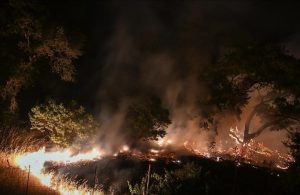Drones continue to buzz over US bases. The military isn’t sure why or how to stop them
6 min readA series of drone sightings over military bases across the country has renewed concerns that the US doesn’t have clear government-wide policy for how to deal with unauthorized incursions that could potentially pose a national security threat.
“We’re one year past Langley drone incursions and almost two years past the PRC spy balloon. Why don’t we have a single [point of contact] who is responsible for coordination across all organizations in the government to address this?” the recently retired head of US Northern Command and NORAD, Gen. Glen VanHerck, told CNN. “Instead, everybody’s pointing their fingers at each other saying it’s not our responsibility.”
Indeed, there have been multiple instances of drone incursions over military bases since mysterious drone swarms were spotted around Joint Base Langley-Eustis and other sensitive military sites in Virginia last year, and since a Chinese spy balloon transited the continental US in 2023.

Over a period of six days earlier this month, there were six instances of unmanned aerial systems, or drones, entering the airspace of the Marine Corps base Camp Pendleton in California, a spokesperson confirmed to CNN, adding that they posed “no threat to installation operations and no impact to air and ground operations.” There have also been incidents in the last month at Wright-Patterson Air Force Base, Ohio; Picatinny Arsenal, New Jersey; Naval Weapons Station Earle, New Jersey; and Vandenberg Space Force Base, California.
A Chinese citizen, who is a lawful permanent resident of the US, was recently arrested in connection to the California incident.
The drone incidents are “a problem that has been brewing for over a decade and we have basically failed to address it,” said retired Air Force Brig. Gen. Rob Spalding, who previously served as the chief China strategist for the Joint Chiefs of Staff and senior director for strategic planning on the National Security Council.
It’s unclear what specifically the drones could be doing — the intent could be anything from attempting to gather intelligence on the base or testing its defenses and response time, to gaining a better understanding of how the bases work, or they could simply be harmless hobbyists flying drones too close to restricted areas.
A flurry of sightings across multiple states
But the issue isn’t just impacting military installations; in recent weeks, a flurry of drone sightings across multiple states has garnered media attention and led politicians to call for the government to take action. Officials have stressed that they don’t believe the drones spotted in New Jersey and other states pose a national security or public safety risk, attributing many of the sightings to explainable instances of confusion with manned fixed-wing aircraft, helicopters or hobbyist drones.
“I can’t rule out the fact that we might find some sort of illegal or criminal activity, some nefarious activity, (but) all I can do is tell you that right now we see none of that,” National Security Council spokesman John Kirby said this week.

But as one Senate aide familiar with discussions on drone defense and policy told CNN, just because the drones aren’t directly impacting the military or military installations “doesn’t mean it’s not a national security issue.”
Despite the incursions and the risk they could pose, officials say there is no coordinated policy to determine what agency leads the response to such activity, or how to determine where the drones originate. CNN reported this week that government agencies have struggled to keep pace with the development of drones and drone technology, particularly by adversaries like China, though legislation is being discussed and the Pentagon just recently released its strategy for countering unmanned systems.
The Senate aide said the gray area between posing a risk to the military and posing a threat to the public is part of the problem in authorities — “if it’s not strictly DOD then it must be DHS, but we just kind of go ‘round and ‘round.”
The challenges the US national security establishment faces when it comes to drone operations, as well as operations in the cyber and information environments, have been pointed to repeatedly and publicly by military officials and lawmakers. In 2023, VanHerck said in a NORAD/NORTHCOM posture statement that the US must “move beyond outdated assumptions and plans” in order to defend the homeland.
“In an era of incredible innovation and technological achievement, inflexible, outdated processes are a greater impediment to success than many of our competitors’ capability advancements,” he said.
The two heads of the Senate Armed Services Committee, Sens. Jack Reed and Roger Wicker, sounded the alarm in a Washington Post op-ed at the beginning of 2024 that the US “lacks adequate drone detection capability” and that agencies “lack clear lines of authority about which agency is responsible for stopping these incursions.”
Military installations have the authority to protect themselves and respond to threats, but a former senior military official said that if the drone enters the airspace and subsequently leaves, determining where the drone originated from and what it was doing can be difficult. Military law enforcement typically coordinates with civilian law enforcement off base in that instance, the former official said, but are often limited in what they can do given laws that restrict intelligence collection within US borders.
Catching up with a new phenomenon
But sources also said the lack of ability to do more also stems at times from a failure to prioritize defense against this kind of activity within the US. The topic is “such a relatively new phenomenon that the law has not caught up and the agencies have not adapted quickly enough,” the Senate aide said.
“We’re going to get there, but it’s a pretty surprising gap that can be exploited,” they said, adding that until there’s “clear leadership from the White House, this is all going to keep spinning.”
Experts also pointed to what they described as a generalized belief in the US that conflict primarily happens abroad, and that the national security establishment hasn’t adjusted quickly enough to threats at home. Spalding said the US has been “focused on the away game, which has left us incredibly vulnerable at home as technology has advanced.”
“We have a perception that the fight will occur elsewhere, that a fight with China will happen in the South China Sea or Taiwan, or with Russia in Europe. It’s happening right now — in the cyber domain or information space — every single day here,” VanHerck told CNN.
The former senior military official said that over the years, a number of senior military commanders have testified before Congress about gaps in domain awareness in the US and limitations on the US’ ability to detect drones and more broadly defend the homeland. And while lawmakers generally seem receptive, and to understand the problem, that understanding hasn’t been reflected in policy, the official said.
The need for Congressional action was made clear in a joint statement this week from the DoD, Department of Homeland Security, Federal Bureau of Investigations and Federal Aviation Administration. The agencies said they “urge Congress to enact counter-UAS legislation when it reconvenes that would extend and expand existing counter-drone authorities to identify and mitigate any threat that may emerge.”
“[The drone issue] is not something we can deal with at scale anytime soon,” Spalding said, “unless we can raise the alarm at a much higher level and deal with the political repercussions of the fallout.”
By Haley Britzky, CNN







